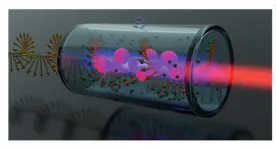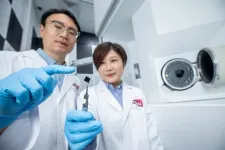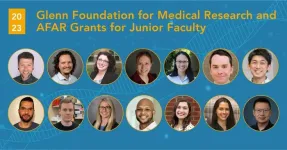(Press-News.org) Creating artificial life is a recurring theme in both science and popular literature, where it conjures images of creeping slime creatures with malevolent intentions or super-cute designer pets. At the same time, the question arises: What role should artificial life play in our environment here on Earth, where all life forms are created by nature and have their own place and purpose?
Associate professor Chenguang Lou from the Department of Physics, Chemistry, and Pharmacy, University of Southern Denmark, together with Professor Hanbin Mao from Kent State University, is the parent of a special artificial hybrid molecule that could lead to the creation of artificial life forms. They have now published a review in the journal Cell Reports Physical Science on the state of research in the field behind their creation. The field is called "hybrid peptide-DNA nanostructures," and it is an emerging field, less than ten years old.
Lou's vision is to create viral vaccines (modified and weakened versions of a virus) and artificial life forms that can be used for diagnosing and treating diseases.
"In nature, most organisms have natural enemies, but some do not. For example, some disease-causing viruses have no natural enemy. It would be a logical step to create an artificial life form that could become an enemy to them," he says.
Similarly, he envisions such artificial life forms can act as vaccines against viral infection and can be used as nanorobots or nanomachines loaded with medication or diagnostic elements and sent into a patient's body.
"An artificial viral vaccine may be about 10 years away. An artificial cell, on the other hand, is on the horizon because it consists of many elements that need to be controlled before we can start building with them. But with the knowledge we have, there is, in principle, no hindrance to produce artificial cellular organisms in the future," he says.
What are the building blocks that Lou and his colleagues in this field will use to create viral vaccines and artificial life? DNA and peptides are some of the most important biomolecules in nature, making DNA technology and peptide technology the two most powerful molecular tools in the nanotechnological toolkit today. DNA technology provides precise control over programming, from the atomic level to the macro level, but it can only provide limited chemical functions since it only has four bases: A, C, G, and T. Peptide technology, on the other hand, can provide sufficient chemical functions on a large scale, as there are 20 amino acids to work with. Nature uses both DNA and peptides to build various protein factories found in cells, allowing them to evolve into organisms.
Recently, Hanbin Mao and Chenguang Lou have succeeded in linking designed three-stranded DNA structures with three-stranded peptide structures, thus creating an artificial hybrid molecule that combines the strengths of both. This work was published in Nature Communications in 2022. (read the article here "Chirality transmission in macromolecular domains" and the press release at https://www.sdu.dk/en/om_sdu/fakulteterne/naturvidenskab/nyheder-2022/supermolekyle)
Elsewhere in the world, other researchers are also working on connecting DNA and peptides because this connection forms a strong foundation for the development of more advanced biological entities and life forms.
At Oxford University, researchers have succeeded in building a nanomachine made of DNA and peptides that can drill through a cell membrane, creating an artificial membrane channel through which small molecules can pass. (Spruijt et al., Nat. Nanotechnol. 2018, 13, 739-745)
At Arizona State University, Nicholas Stephanopoulos and colleagues have enabled DNA and peptides to self-assemble into 2D and 3D structures. (Buchberger et al., J. Am. Chem. Soc. 2020, 142, 1406-1416)
At Northwest University, researchers have shown that microfibers can form in conjunction with DNA and peptides self-assembling. DNA and peptides operate at the nano level, so when considering the size differences, microfibers are huge. (Freeman et al., Science, 2018, 362, 808-813)
At Ben-Gurion University of the Negev, scientists have used hybrid molecules to create an onion-like spherical structure containing cancer medication, which holds promise to be used in the body to target cancerous tumors. (Chotera et al., Chem. Eur. J., 2018, 24, 10128-10135)
"In my view, the overall value of all these efforts is that they can be used to improve society's ability to diagnose and treat sick people. Looking forward, I will not be surprised that one day we can arbitrarily create hybrid nanomachines, viral vaccines and even artificial life forms from these building blocks to help the society to combat those difficult-to-cure diseases. It would be a revolution in healthcare," says Chenguang Lou.
END
The medicine of the future could be artificial life forms
2023-10-05
ELSE PRESS RELEASES FROM THIS DATE:
Scientists discover the highest energy gamma-rays ever from a pulsar
2023-10-05
Scientists using the H.E.S.S. observatory in Namibia have detected the highest energy gamma rays ever from a dead star called a pulsar. The energy of these gamma rays clocked in at 20 tera-electronvolts, or about ten trillion times the energy of visible light. This observation is hard to reconcile with the theory of the production of such pulsed gamma rays, as the international team reports in the journal Nature Astronomy.
Pulsars are the left-over corpses of stars that spectacularly exploded in a supernova. The explosions leave behind ...
Discovery made by University of Warsaw scientists may enable network interface for quantum computers
2023-10-05
A team of scientists at the QOT Centre for Quantum Optical Technologies, including a student from the Faculty of Physics (University of Warsaw), made a device capable of the conversion of quantum information between microwave and optical photons. The results of research, published in “Nature Photonics” magazine, highlight a new microwave detection method with possible applications in quantum technologies, as a part of quantum network infrastructure, and in microwave radio-astronomy.
Conversion of quantum information
Whenever you listen to a song on your phone or computer, a conversion of information happens – ...
Risk of gastrointestinal adverse events associated with glucagon-like peptide-1 receptor agonists for weight loss
2023-10-05
About The Study: This study found that use of glucagon-like peptide-1 agonists for weight loss compared with use of bupropion-naltrexone was associated with increased risk of pancreatitis, gastroparesis, and bowel obstruction but not biliary disease. Given the wide use of these drugs, these adverse events, although rare, must be considered by patients who are contemplating using the drugs for weight loss because the risk-benefit calculus for this group might differ from that of those who use them for diabetes.
Authors: Mahyar Etminan, Pharm.D., M.Sc., of the University of British Columbia in Vancouver, is the corresponding author.
To access the embargoed study: Visit ...
UK study shows hybrid closed-loop technology improved maternal glucose levels during pregnancy complicated by type 1 diabetes
2023-10-05
For pregnant women with type 1 diabetes, a technology giving insulin doses, as informed by a smartphone algorithm, helps them better manage their blood sugars compared with traditional insulin pumps or multiple daily injections, according to a new randomised trial published in The New England Journal of Medicine (NEJM) and presented at the European Association for the Study of Diabetes (EASD) meeting in Hamburg (2-6 October).
Despite better systems for monitoring blood sugars and delivering insulin, hormonal changes and altered eating patterns during pregnancy mean that ...
Successful morphing of inorganic perovskites without damaging their functional properties
2023-10-05
A research team co-led by scholars from City University of Hong Kong (CityU) has successfully morphed all-inorganic perovskites at room temperature without compromising their functional properties. Their findings demonstrate the potential of this class of semiconductors for manufacturing next-generation deformable electronics and energy systems in the future.
All-inorganic lead halide perovskites are becoming increasingly important semiconducting materials in energy conversion and optoelectronics because of their outstanding performance and enhanced environmental stability.
“However, unlike metal ...
MD Anderson launches collaborative initiative to reduce breast cancer disparities in Houston area
2023-10-05
HOUSTON ― The University of Texas MD Anderson Cancer Center today announced the launch of Texas Health Equity Alliance for Breast Cancer (THEAL), a community-wide health care initiative to reduce breast cancer disparities in the Houston area, particularly for Black women.
THEAL builds upon the expertise of MD Anderson’s Department of Health Disparities Research in addressing the determinants of cancer disparities while leveraging the cancer prevention and control platform’s experience in leading cross-sector collaboratives ...
In checking chess’s gender bias, researchers find parents and mentors shortchange girls’ potential
2023-10-05
“The Queen’s Gambit” miniseries portrayed the life of a fictional chess prodigy, Beth Harmon, who is continuously underestimated in male-dominated competitions. A team of New York University psychology researchers has now found some “real-life” evidence of what Harmon faced as a younger player: Parents and coaches of youth chess players peg the highest potential rating of girl players to be lower than that of boy players.
Moreover, the study’s authors, who included Jennifer Shahade, a two-time US Women’s Chess champion, found ...
Female chess players may experience gender bias from parents, mentors
2023-10-05
Young female chess players often face gender bias both in the male-dominated chess world and among parents and mentors who believe girls have less potential to succeed in chess than boys, according to research published by the American Psychological Association.
“It’s disheartening to see young female players’ potential downgraded, even by the people who are closest to them, like their parents and coaches,” said lead researcher Sophie Arnold, a doctoral student at New York University.
The study, which was published online in the Journal of Experimental Psychology: General, presents what the researchers say is the first large-scale ...
US cancer centers continue to see chemotherapy shortages, according to update from NCCN
2023-10-05
PLYMOUTH MEETING, PA [October 5, 2023] — The National Comprehensive Cancer Network® (NCCN®)—a non-profit alliance of leading cancer centers across the United States—has released a follow-up survey on the ongoing chemotherapy shortages: 72% of the centers surveyed continue to experience a shortage of carboplatin and 59% are still seeing a shortage of cisplatin. Overall, 86% of centers surveyed reported experiencing a shortage of at least one type of anti-cancer drug.
View the updated survey results at NCCN.org/platinum-update.
The NCCN Best Practices Committee originally shared survey results ...
Announcing 2023 Glenn Foundation for Medical Research and AFAR Research Grants for Junior Faculty
2023-10-05
NEW YORK, NY and SANTA BARBARA, CA – The American Federation for Aging Research (AFAR) and the Glenn Foundation for Medical Research are pleased to announce the 2023 Glenn Foundation for Medical Research and AFAR Research Grants for Junior Faculty recipients.
The Research Grant for Junior Faculty provides an early career investigator with up to $150,000 for one to two ...




